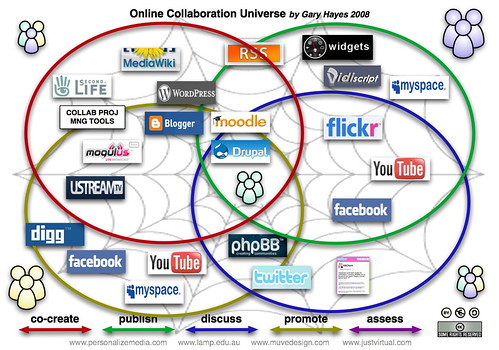This image represents the vast impact technology can have on our ability to convey our messages, share our thoughts and tell our stories. In my estimation technology is a currency of communication as it plays a critical role in the ways in which knowledge creates access to varying degrees of power and influence, or the lack thereof. Postman discusses the costs and benefits, and gains and losses associated with emerging technologies. (Neil Postman, Technopoly, 1992) The implications are wide reaching as it relates to fundraising. Gain can be perceived as the ability to access a wider range of technologies to implement fundraising campaigns that reach more donors in the private sector as public funding rapidly diminishes. On the other hand, the lag time for adapting these new technologies for use in an arena where methods of fundraising have been more traditional can be viewed as a loss.
With the rapid uptake of Web 2.0 as tools for fundraising it has been absolutely necessary to continuously merge old and new technologies. The reason for this has been to accommodate a wide donor base that resides on both sides of the digital divide.
A great deal of my work is with colleagues who are considered more technophobes than technophiles and my challenge is to refocus their kaleidoscopic view of technology, shifting their understanding of how it can be used to improve the efficacy of current fundraising models. I constantly work to incorporate relevant text into the seemingly unlimited forms of technology in order to make a significant impact around breaking down the stigma pervading mental health. As a fundraiser, working to educate and steward potential donors around a cause that has low acceptance and visibility, it becomes even more imperative to utilize information technologies in a productive and cost efficient manner.
A brilliant example of how technology is being employed to breakdown stigma around mental illness can be found in actor Glenn Close’s “Bring Change 2 Mind” campaign. Here is a woman in a position of power using her influence to bring awareness, rebuilding community and support through the use of text and technology as communication tools. This anti-stigma campaign demonstrates how technology and text can be used in conjunction to disturb, upset and hopefully transform our current cultural perceptions and biases around a disease that dares not speak its name, let alone write it.

In his book “Bias of Communication”, Harold Innis writes, “…sudden extensions of communications are reflected in cultural disturbances”. (ETEC540 Prefatory Materials) Perhaps shifting my colleagues’ technology kaleidoscopes will begin a cultural disturbance that will result in better understanding and support for those we are working to help.





Like your posting and yes technology can break through barriers that previously were hard to tear down.
Leslie
I really enjoyed your post. You make a lot of interesting points.
I really like that chart for online collaboration.
The idea of causing a cultural disturbance is an interesting one. I do feel a lot of frustration due to the resistance of my colleagues (and school board) to even get their feet wet with technology. I know that many of them will not be embracing technology anytime soon, but what I find troubling is the refusal to try anything or even keep an open mind. All the convincing and examples hasn’t really achieved much, so disturbance maybe what is needed.
Danny